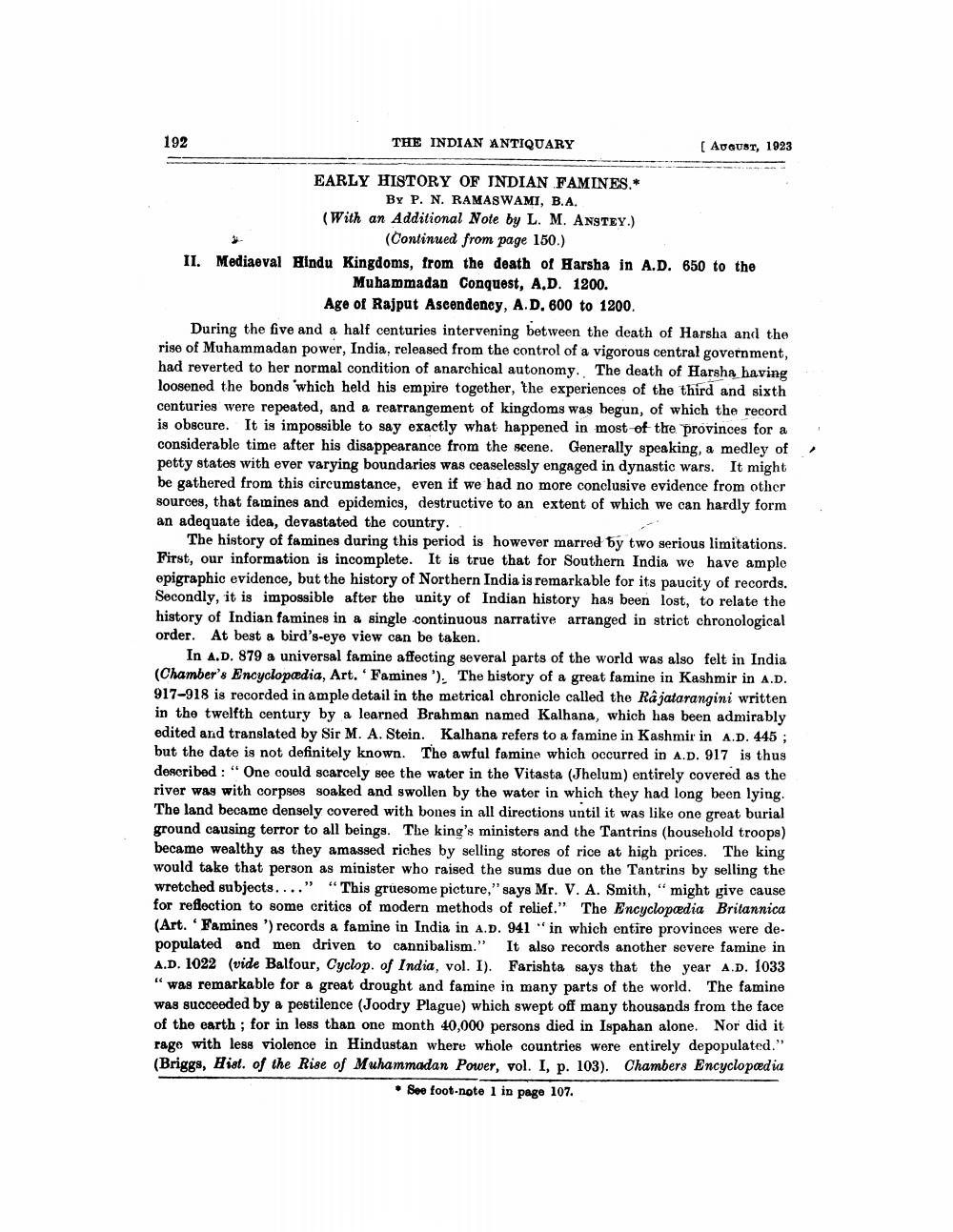________________
192
THE INDIAN ANTIQUARY
(AUGUST, 1923
EARLY HISTORY OF INDIAN FAMINES.*
By P. N. RAMASWAMI, B.A. (With an Additional Note by L. M. ANSTEY.)
(Continued from page 150.) II. Mediaeval Hindu Kingdoms, from the death of Harsha in A.D. 650 to the
Muhammadan Conquest, A.D. 1200.
Age of Rajput Ascendeney, A.D. 600 to 1200. During the five and a half centuries intervening between the death of Harsha and the rise of Muhammadan power, India, released from the control of a vigorous central government, had reverted to her normal condition of anarchical autonomy. The death of Harsha having loosened the bonds which held his empire together, the experiences of the third and sixth centuries were repeated, and a rearrangement of kingdoms was begun, of which the record is obscure. It is impossible to say exactly what happened in most of the provinces for a considerable time after his disappearance from the scene. Generally speaking, a medley of petty states with ever varying boundaries was ceaselessly engaged in dynastic wars. It might be gathered from this circumstance, even if we had no more conclusive evidence from other sources, that famines and epidemics, destructive to an extent of which we can hardly form an adequate idea, devastated the country,
The history of famines during this period is however marred by two serious limitations. First, our information is incomplete. It is true that for Southern India we have ample epigraphic evidence, but the history of Northern India is remarkable for its paucity of records. Secondly, it is impossible after the unity of Indian history has been lost, to relate the history of Indian famines in a single continuous narrative arranged in strict chronological order. At best a bird's-eye view can be taken.
In A.D. 879 a universal famine affecting several parts of the world was also felt in India (Chamber's Encyclopædia, Art. 'Famines '). The history of a great famine in Kashmir in A.D. 917-918 is recorded in ample detail in the metrical chronicle called the Rajatarangini written in the twelfth century by a learned Brahman named Kalhana, which has been admirably edited and translated by Sir M. A. Stein. Kalhana refers to a famine in Kashmir in A.D. 445 ; but the date is not definitely known. The awful famine which occurred in A.D. 917 is thus described : "One could scarcely see the water in the Vitasta (Jhelum) entirely covered as the river was with corpses soaked and swollen by the water in which they had long been lying. The land became densely covered with bones in all directions until it was like one great burial ground causing terror to all beings. The king's ministers and the Tantrins (household troops) became wealthy as they amassed riches by selling stores of rice at high prices. The king would take that person as minister who raised the sums due on the Tantrins by selling the wretched subjects...." "This gruesome picture," says Mr. V. A. Smith, "might give cause for reflection to some critics of modern methods of relief." The Encyclopædia Britannica (Art. Famines') records a famine in India in A.D. 941 in which entire provinces were de. populated and men driven to cannibalism." It also records another severe famine in A.D. 1022 (vide Balfour, Cyclop. of India, vol. I). Farishta says that the year A.D. 1033 " was remarkable for a great drought and famine in many parts of the world. The famine was succeeded by a pestilence (Joodry Plague) which swept off many thousands from the face of the earth; for in less than one month 40,000 persons died in Ispahan alone. Nor did it rage with less violence in Hindustan where whole countries were entirely depopulated." (Briggs, Hist. of the Rise of Muhammadan Power, vol. I, p. 103). Chambers Encyclopædia
• See foot-note 1 in page 107.




